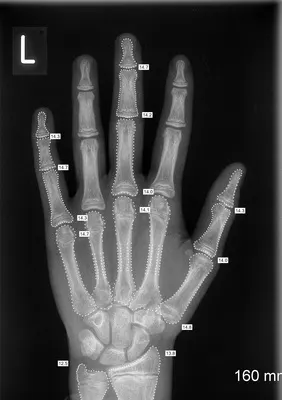How to interpret Bone Age X-rays: A Comprehensive Guide
Introduction
Bone Age X-rays play a pivotal role in pediatric healthcare, providing insights into a child's growth and development. This guide aims to familiarize readers with Bone Age X-rays and offer comprehensive methods for interpreting them.
Understanding Bone Age X-rays
A Bone Age X-ray is a specialized radiologic test that assesses the maturation of bones, predominantly in children. This section will explore what Bone Age X-rays are and their significance in pediatric care.

What Do Bone Age X-rays Show?
- Growth Disorders: Identification and monitoring of growth disorders like growth hormone deficiency or precocious puberty.
- Bone Maturation: Evaluating the development and maturation of bones, particularly in the hands and wrists.
- Endocrine Issues: Detecting underlying endocrine disorders affecting growth.
- Genetic Conditions: Assessing genetic conditions that impact bone development.
When Will You Get One?
- Developmental Check-ups: During regular pediatric assessments, especially if growth concerns exist.
- Endocrine Evaluation: For children suspected of having hormonal imbalances affecting growth.
- Genetic Disorder Investigation: In cases of suspected genetic disorders impacting physical development.
- Orthopedic Assessment: Before orthopedic surgeries or treatments involving growth plates.
Methods to Interpret Bone Age X-rays
Interpreting Bone Age X-rays requires a nuanced understanding of pediatric radiology. Below are three methods suited for different expertise levels and contexts.
1. Utilizing X-ray Interpreter
X-ray Interpreter offers AI-powered interpretations of Bone Age X-rays, providing accurate and fast analysis. Here's how to use it:
- Registration: Sign up on X-ray Interpreter for AI-driven analysis.
- Uploading X-rays: Upload the Bone Age X-ray images.
- Reviewing Interpretation: Access the AI-generated report and review it.
- Professional Consultation: For further understanding, seek advice from pediatric radiologists.
Check our get started guide for more.
2. Using ChatGPT Plus
ChatGPT Plus, with the advanced GPT-4V model, offers interactive and refined analysis of Bone Age X-rays:
- Subscription: Subscribe to ChatGPT Plus for access.
- Uploading X-rays: Upload images on the OpenAI platform.
- Requesting Analysis: Ask the AI for a detailed analysis.
- Reviewing and Confirming: Iterate with the AI to refine the interpretation.
- Expert Validation: Consult pediatric radiologists to confirm the findings.
Read more on how to use ChatGPT for X-ray analysis.
Alternatively, as several other AI models with vision capabilities emerge, you can also try other models, such as Grok by xAI, Claude by Anthropic, Gemini by Google Deepmind.
3. Reading Bone Age X-rays by Yourself
This traditional method is ideal for medical professionals:
- Education: Gain knowledge in pediatric radiology.
- Practice: Regularly interpret Bone Age X-rays with expert guidance.
- Resources: Use educational materials for continuous learning.
- Feedback: Get input from experienced radiologists.
- Ongoing Learning: Stay updated with current research and practices.
Recommended Resources for Self-Reading:
-
KidsHealth - Bone Age X-ray: This resource offers parents and caregivers a comprehensive understanding of Bone Age X-rays, detailing their purpose, process, and significance in monitoring children's growth and development.
-
Radiopaedia - Bone age (radiograph): A detailed reference article on the bone age radiograph, covering indications, patient positioning, technical factors, image technical evaluation, and practical points of bone age assessment.
-
Frontiers - Evaluation of Bone Age in Children: A Mini-Review: This mini-review provides an in-depth analysis of bone age evaluation, discussing various methods and their applications, standardization of hand and wrist radiography, and computerized systems for reading bone age.
These resources offer diverse learning opportunities to improve Bone Age X-ray interpretation skills.
Comparative Analysis
Comparing the methods to interpret Bone Age X-rays is crucial for selecting the most appropriate approach. We examine X-ray Interpreter, ChatGPT Plus, and Self-Reading based on accuracy, user-friendliness, cost, efficiency, learning curve, and resource availability.
| Criteria | X-ray Interpreter | ChatGPT Plus | Self-Reading |
|---|---|---|---|
| Accuracy | Mostly High (AI-based)1 | Mostly High (AI-based)1 | Varies (Skill-dependent) |
| Ease of Use | Easy | Moderate | Challenging |
| Cost | Starting from $2.50 per image | $20 per month | Free (excluding educational costs) |
| Time Efficiency | Fast | Moderate to Fast | Slow to Moderate |
| Learning Curve | Low | Low to Moderate | High |
| Additional Resources | Provided | Partially Provided (through OpenAI) | Self-sourced |
This table helps you understand each method's strengths and limitations, aiding in making an informed choice.
Conclusion
Bone Age X-ray interpretation is vital in pediatric healthcare. This guide presents three methods: X-ray Interpreter, ChatGPT Plus, and self-reading. Each caters to different needs and expertise levels.
AI-powered X-ray Interpreter and ChatGPT Plus offer quick and accurate interpretations, suitable for varied users. Self-reading, on the other hand, is ideal for professionals seeking to deepen their radiological skills.
By understanding these methods and leveraging available resources, you can effectively interpret Bone Age X-rays, contributing significantly to pediatric patient care.
Resources and Further Learning
For those looking to expand their knowledge in Bone Age X-ray interpretation, several resources are available:
-
Radiopaedia - Bone Age Assessment: This article discusses the use of bone age assessment in diagnosing various growth disorders and predicting final height in children with short stature. It also covers the assessment process and compares different atlases used for bone age assessment.
-
Cincinnati Children's - Bone Age X-Ray: An overview of what a bone age X-ray is, why it's done, and how it's conducted. This resource is particularly useful for parents and caregivers, providing insights into the preparation, procedure, and what to expect during a bone age X-ray.
-
Norton Children's - X-Ray Exam: Bone Age Study: This article offers a detailed explanation of a bone age study, its purpose, how the procedure is conducted, and how the results are used by healthcare providers. It also discusses the significance of bone age compared to chronological age and its implications.
These resources cater to various expertise levels, providing essential information and guidance in Bone Age X-ray interpretation.